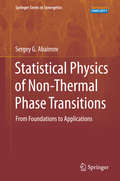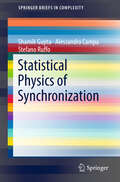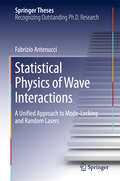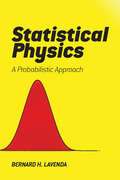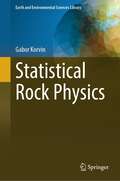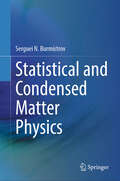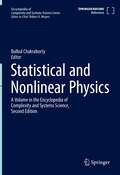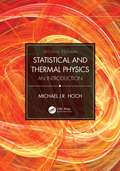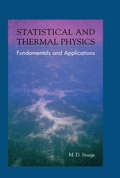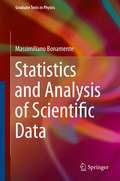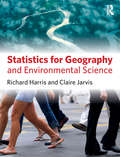- Table View
- List View
Statistical Physics of Non-Thermal Phase Transitions
by Sergey G. AbaimovThis book addresses the application of methods used in statistical physics to complex systems--from simple phenomenological analogies to more complex aspects, such as correlations, fluctuation-dissipation theorem, the concept of free energy, renormalization group approach and scaling. Statistical physics contains a well-developed formalism that describes phase transitions. It is useful to apply this formalism for damage phenomena as well. Fractals, the Ising model, percolation, damage mechanics, fluctuations, free energy formalism, renormalization group, and scaling, are some of the topics covered in Statistical Physics of Phase Transitions.
Statistical Physics of Particles
by Mehran KardarStatistical physics has its origins in attempts to describe the thermal properties of matter in terms of its constituent particles, and has played a fundamental role in the development of quantum mechanics. Based on lectures taught by Professor Kardar at MIT, this textbook introduces the central concepts and tools of statistical physics. It contains a chapter on probability and related issues such as the central limit theorem and information theory, and covers interacting particles, with an extensive description of the van der Waals equation and its derivation by mean field approximation. It also contains an integrated set of problems, with solutions to selected problems at the end of the book and a complete set of solutions is available to lecturers on a password protected website at www. cambridge. org/9780521873420. A companion volume, Statistical Physics of Fields, discusses non-mean field aspects of scaling and critical phenomena, through the perspective of renormalization group.
Statistical Physics of Synchronization (SpringerBriefs in Complexity)
by Shamik Gupta Alessandro Campa Stefano RuffoThis book introduces and discusses the analysis of interacting many-body complex systems exhibiting spontaneous synchronization from the perspective of nonequilibrium statistical physics. While such systems have been mostly studied using dynamical system theory, the book underlines the usefulness of the statistical physics approach to obtain insightful results in a number of representative dynamical settings. Although it is intractable to follow the dynamics of a particular initial condition, statistical physics allows to derive exact analytical results in the limit of an infinite number of interacting units. Chapter one discusses dynamical characterization of individual units of synchronizing systems as well as of their interaction and summarizes the relevant tools of statistical physics. The latter are then used in chapters two and three to discuss respectively synchronizing systems with either a first- or a second-order evolution in time. This book provides a timely introduction to the subject and is meant for the uninitiated as well as for experienced researchers working in areas of nonlinear dynamics and chaos, statistical physics, and complex systems.
Statistical Physics of Wave Interactions
by Fabrizio AntenucciThis thesis reveals the utility of pursuing a statistical physics approach in the description of wave interactions in multimode optical systems. To that end, the appropriate Hamiltonian models are derived and their limits of applicability are discussed. The versatility of the framework allows the characterization of ordered and disordered lasers in open and closed cavities in a unified scheme, from standard mode-locking to random lasers. With the use of replica method and Monte Carlo simulations, the models are categorized on the basis of universal properties, and nontrivial predictions of experimental relevance are obtained. In particular, the approach makes it possible to nonperturbatively treat the interplay between disorder and nonlinearity and to envisage novel and fascinating physical phenomena such as glassy random lasers, providing a novel way to experimentally investigate replica symmetry breaking.
Statistical Physics: A Probabilistic Approach
by Bernard H. LavendaSuitable for graduate students in chemical physics, statistical physics, and physical chemistry, this text develops an innovative, probabilistic approach to statistical mechanics. The treatment employs Gauss's principle and incorporates Bose-Einstein and Fermi-Dirac statistics to provide a powerful tool for the statistical analysis of physical phenomena. The treatment begins with an introductory chapter on entropy and probability that covers Boltzmann's principle and thermodynamic probability, among other topics. Succeeding chapters offer a case history of black radiation, examine quantum and classical statistics, and discuss methods of processing information and the origins of the canonical distribution. The text concludes with explorations of statistical equivalence, radiative and material phase transitions, and the kinetic foundations of Gauss's error law. Bibliographic notes complete each chapter.
Statistical Rock Physics (Earth and Environmental Sciences Library)
by Gabor KorvinThe book is the first systematic and comprehensive treatise of stochastic models and computational tools that have emerged in rock-physics in the last 20 years. The field of statistical rock-physics is a part of rock-physics (Petrophysics). Its concepts, methods and techniques are borrowed from stochastic geometry and statistical physics. This discipline describes the interior geometry of rocks; derives their effective physical properties based on their random composition and the random arrangement of their constituents; and builds models to simulate the past geological processes that had formed the rock. The aim of the book is to help the readers to understand the claims, techniques and published results of this new field and—most importantly—to teach them in order to creatively apply stochastic geometry and statistical physics in their own research tasks. For this purpose, the underlying mathematics will be discussed in all sections of the book; numerical solutions will be highlighted; a full set of references will be provided; and theory will go hand-in-hand with practical applications to hydraulic permeability, electric conduction, rock failure, NMR, mechanics of random grain packings, as well as the compaction of shale.
Statistical and Condensed Matter Physics
by Serguei N. BurmistrovThe book outlines the fundamentals of statistical and condensed matter physics. The statistical physics is the basis of condensed matter physics and the tool for studying a variety of condensed media in the thermodynamic (heat) conditions. The statistical physics is presented within the framework of canonical Gibbs distribution entailing the relations known from the classical (heat) thermodynamics. The application of the statistical theory embraces such topics as ideal classical and quantum gases, Bose-type excitations, phase transitions and critical phenomena, normal Fermi liquid, superconductivity, weakly non-ideal Bose gases, superfluidity, and magnetism. Each section ends with one or several problems with the solutions clarifying the paragraph content and delivering some additional physical examples. The problems give an opportunity for a reader to check the own real knowledge of the material studied.
Statistical and Nonlinear Physics (Encyclopedia of Complexity and Systems Science Series)
by Bulbul ChakrabortyThis volume of the Encyclopedia of Complexity and Systems Science, Second Edition, focuses on current challenges in the field from materials and mechanics to applications of statistical and nonlinear physics in the life sciences. Challenges today are mostly in the realm of non-equilibrium systems, although certain equilibrium systems also present serious hurdles. Where possible, pairwise articles focus on a single topic, one from a theoretical perspective and the other from an experimental one, providing valuable insights. In other cases, theorists and experimentalists have collaborated on a single article. Coverage includes both quantum and classical systems, and emphasizes 1) mature fields that are not covered in the current specialist literature, (2) topics that fall through the cracks in disciplinary journals/books, or (3) developing areas where the knowledge base is large and robust and upon which future developments will depend. The result is an invaluable resource for condensed matter physicists, material scientists, engineers and life scientists.
Statistical and Thermal Physics: An Introduction
by Michael J.R. HochThermal and statistical physics has established the principles and procedures needed to understand and explain the properties of systems consisting of macroscopically large numbers of particles. By developing microscopic statistical physics and macroscopic classical thermodynamic descriptions in tandem, Statistical and Thermal Physics: An Introduction provides insight into basic concepts and relationships at an advanced undergraduate level. This second edition is updated throughout, providing a highly detailed, profoundly thorough, and comprehensive introduction to the subject and features exercises within the text as well as end-of-chapter problems. Part I of this book consists of nine chapters, the first three of which deal with the basics of equilibrium thermodynamics, including the fundamental relation. The following three chapters introduce microstates and lead to the Boltzmann definition of the entropy using the microcanonical ensemble approach. In developing the subject, the ideal gas and the ideal spin system are introduced as models for discussion. The laws of thermodynamics are compactly stated. The final three chapters in Part I introduce the thermodynamic potentials and the Maxwell relations. Applications of thermodynamics to gases, condensed matter, and phase transitions and critical phenomena are dealt with in detail. Initial chapters in Part II present the elements of probability theory and establish the thermodynamic equivalence of the three statistical ensembles that are used in determining probabilities. The canonical and the grand canonical distributions are obtained and discussed. Chapters 12-15 are concerned with quantum distributions. By making use of the grand canonical distribution, the Fermi–Dirac and Bose–Einstein quantum distribution functions are derived and then used to explain the properties of ideal Fermi and Bose gases. The Planck distribution is introduced and applied to photons in radiation and to phonons on solids. The last five chapters cover a variety of topics: the ideal gas revisited, nonideal systems, the density matrix, reactions, and irreversible thermodynamics. A flowchart is provided to assist instructors on planning a course. Key Features: Fully updated throughout, with new content on exciting topics, including black hole thermodynamics, Heisenberg antiferromagnetic chains, entropy and information theory, renewable and nonrenewable energy sources, and the mean field theory of antiferromagnetic systems Additional problem exercises with solutions provide further learning opportunities Suitable for advanced undergraduate students in physics or applied physics. Michael J.R. Hoch spent many years as a visiting scientist at the National High Magnetic Field Laboratory at Florida State University, USA. Prior to this, he was a professor of physics and the director of the Condensed Matter Physics Research Unit at the University of the Witwatersrand, Johannesburg, where he is currently professor emeritus in the School of Physics.
Statistical and Thermal Physics: Fundamentals and Applications
by M.D. SturgeThis book is based on many years of teaching statistical and thermal physics. It assumes no previous knowledge of thermodynamics, kinetic theory, or probability---the only prerequisites are an elementary knowledge of classical and modern physics, and of multivariable calculus. The first half of the book introduces the subject inductively but rigorously, proceeding from the concrete and specific to the abstract and general. In clear physical language the book explains the key concepts, such as temperature, heat, entropy, free energy, chemical potential, and distributions, both classical and quantum. The second half of the book applies these concepts to a wide variety of phenomena, including perfect gases, heat engines, and transport processes. Each chapter contains fully worked examples and real-world problems drawn from physics, astronomy, biology, chemistry, electronics, and mechanical engineering.
Statistics and Analysis of Scientific Data
by Massimiliano BonamenteStatistics and Analysis of Scientific Data covers the foundations of probability theory and statistics, and a number of numerical and analytical methods that are essential for the present-day analyst of scientific data. Topics covered include probability theory, distribution functions of statistics, fits to two-dimensional datasheets and parameter estimation, Monte Carlo methods and Markov chains. Equal attention is paid to the theory and its practical application, and results from classic experiments in various fields are used to illustrate the importance of statistics in the analysis of scientific data. The main pedagogical method is a theory-then-application approach, where emphasis is placed first on a sound understanding of the underlying theory of a topic, which becomes the basis for an efficient and proactive use of the material for practical applications. The level is appropriate for undergraduates and beginning graduate students, and as a reference for the experienced researcher. Basic calculus is used in some of the derivations, and no previous background in probability and statistics is required. The book includes many numerical tables of data, as well as exercises and examples to aid the students' understanding of the topic.
Statistics for Geography and Environmental Science
by Richard Harris Claire JarvisStatistics are important tools for validating theory, making predictions and engaging in policy research. They help to provide informed commentary about social and environmental issues, and to make the case for change. Knowledge of statistics is therefore a necessary skill for any student of geography or environmental science. This textbook is aimed at students on a degree course taking a module in statistics for the first time. It focuses on analysing, exploring and making sense of data in areas of core interest to physical and human geographers, and to environmental scientists. It covers the subject in a broadly conventional way from descriptive statistics, through inferential statistics to relational statistics but does so with an emphasis on applied data analysis throughout.
Statistics for Mining Engineering
by Jacek M. CzaplickiMany areas of mining engineering gather and use statistical information, provided by observing the actual operation of equipment, their systems, the development of mining works, surface subsidence that accompanies underground mining, displacement of rocks surrounding surface pits and underground drives and longwalls, amongst others. In addition, th
Statistics for nuclear and particle physicists
by Louis LyonsThis book, written by a non-statistician for non-statisticians, emphasises the practical approach to those problems in statistics which arise regularly in data analysis situations in nuclear and high-energy physics experiments. Rather than concentrating on formal proofs of theorems, an abundant use of simple examples illustrates the general ideas which are presented, showing the reader how to obtain the maximum information from the data in the simplest manner. Possible difficulties with the various techniques, and pitfalls to be avoided, are also discussed. Based on a series of lectures given by the author to both students and staff at Oxford, this common-sense approach to statistics will enable nuclear physicists to understand better how to do justice to their data in both analysis and interpretation.
Statistics of the Galaxy Distribution
by Vicent J. Martinez Enn SaarOver the last decade, statisticians have developed new statistical tools in the field of spatial point processes. At the same time, observational efforts have yielded a huge amount of new cosmological data to analyze. Although the main tools in astronomy for comparing theoretical results with observation are statistical, in recent years, cosmologis
Statistics with Applications in Biology and Geology
by Preben Blaesild Jorgen GranfeldtThe use of statistics is fundamental to many endeavors in biology and geology. For students and professionals in these fields, there is no better way to build a statistical background than to present the concepts and techniques in a context relevant to their interests. Statistics with Applications in Biology and Geology provides a practical introduction to using fundamental parametric statistical models frequently applied to data analysis in biology and geology.Based on material developed for an introductory statistics course and classroom tested for nearly 10 years, this treatment establishes a firm basis in models, the likelihood method, and numeracy. The models addressed include one sample, two samples, one- and two-way analysis of variance, and linear regression for normal data and similar models for binomial, multinomial, and Poisson data. Building on the familiarity developed with those models, the generalized linear models are introduced, making it possible for readers to handle fairly complicated models for both continuous and discrete data. Models for directional data are treated as well. The emphasis is on parametric models, but the book also includes a chapter on the most important nonparametric tests.This presentation incorporates the use of the SAS statistical software package, which authors use to illustrate all of the statistical tools described. However, to reinforce understanding of the basic concepts, calculations for the simplest models are also worked through by hand. SAS programs and the data used in the examples and exercises are available on the Internet.
Statistics: A Guide to the Use of Statistical Methods in the Physical Sciences (Manchester Physics Series #29)
by R. J. BarlowThe Manchester Physics Series General Editors: D. J. Sandiford; F. Mandl; A. C. Phillips Department of Physics and Astronomy, University of Manchester Properties of Matter B. H. Flowers and E. Mendoza Optics Second Edition F. G. Smith and J. H. Thomson Statistical Physics Second Edition F. Mandl Electromagnetism Second Edition I. S. Grant and W. R. Phillips Statistics R. J. Barlow Solid State Physics Second Edition J. R. Hook and H. E. Hall Quantum Mechanics F. Mandl Particle Physics Second Edition B. R. Martin and G. Shaw The Physics of Stars Second Edition A.C. Phillips Computing for Scientists R. J. Barlow and A. R. Barnett Written by a physicist, Statistics is tailored to the needs of physical scientists, containing and explaining all they need to know. It concentrates on parameter estimation, especially the methods of Least Squares and Maximum Likelihood, but other techniques, such as hypothesis testing, Bayesian statistics and non-parametric methods are also included. Intended for reasonably numerate scientists it contains all the basic formulae, their derivations and applications, together with some more advanced ones. Statistics features: * Comprehensive coverage of the essential techniques physical scientists are likely to need. * A wealth of examples, and problems with their answers. * Flexible structure and organisation allows it to be used as a course text and a reference. * A review of the basics, so that little prior knowledge is required.
Status Of Pollinators In North America
by National Research Council of the National AcademiesPollinators&#8212insects, birds, bats, and other animals that carry pollen from the male to the female parts of flowers for plant reproduction&#8212are an essential part of natural and agricultural ecosystems throughout North America. For example, most fruit, vegetable, and seed crops and some crops that provide fiber, drugs, and fuel depend on animals for pollination. This book provides evidence for the decline of some pollinator species in North America, including America’s most important managed pollinator, the honeybee, as well as some butterflies, bats, and hummingbirds. For most managed and wild pollinator species, however, population trends have not been assessed because populations have not been monitored over time. In addition, for wild species with demonstrated declines, it is often difficult to determine the causes or consequences of their decline. This book outlines priorities for research and monitoring that are needed to improve information on the status of pollinators and establishes a framework for conservation and restoration of pollinator species and communities.
Status and Dynamics of Forests in Germany: Results of the National Forest Monitoring (Ecological Studies #237)
by Nicole Wellbrock Andreas BolteThis book is an open access publication.Forest ecosystems in Central Europe are changing as a result of anthropogenic influences and changing climate conditions. As such, a large-scale monitoring programme was undertaken in order to understand the influence of site modification, deposition of air pollutants, and climate. This book presents the scientific findings of this study for Germany, including the major challenges with regard to the future preservation and management of forest ecosystems under environmental change. In addition, it addresses a number of central questions: what are the main factors affecting forest stands and soil integrity? How, and how rapidly, are forest ecosystems changing? How diverse are the changes across Germany? What will be the main risks in sustainable forest management in the future? And how can policy support the development and maintenance of adaptive and resilient forests that provide essential ecosystem services, today and in the future? Helping readers understand the importance of soils and related ecosystem processes for future sustainable forestry, and sharing essential findings on environmental change and related changes in forest status and dynamics, the book is a valuable resource for researchers and policymakers interested in science-based decisions.
Status of Climate Change Adaptation in Asia and the Pacific (Springer Climate)
by Mozaharul Alam Jeongho Lee Puja SawhneyThis volume provides an overview of the climate change adaptation objectives set, actions taken, and challenges faced by several countries in the Asia-Pacific region. The majority of the populations in this region struggle to make a living from subsistence agriculture, and livelihoods are highly dependent on natural ecosystem services which are likely to be severely affected by climate change. Cases discussed in this book highlight successes made by governments towards achieving adaptation objectives, and efforts required to overcome challenges. While significant economic advances have been made, the pace of growth has been slow to impact the lives of a majority of the people who live below the poverty line. The chapters highlight adaptation actions for protecting people and their livelihoods in priority sectors, maintaining food and water security, supporting socio-economic stability including poverty reduction, and climate risk management. This book also maximizes readers' insights into the knowledge gaps and limitations of stated adaptation goals, and the bottlenecks that hinder implementation in different regions.
Status of Decline and Conservation of Amphibians of the Middle East: Amphibian Biology, Volume 11, Part 8 Status of Conservation and Decline of Amphibians: Eastern Hemisphere
by Susan King Indraneil Das Harold HeatwoleAmphibians by virtue of their thin, moist, permeable skins are poorly protected from harsh environments and are especially susceptible to chemical changes, desiccation, and alteration of their habitat. Accordingly, it is not surprising that they manifest exceptionally high rates of extinction and suffer more severe declines than do most other taxa in an environment undergoing unprecedented anthropogenic change. They are especially important to study as they serve as an early-warning system portending changes that are beginning to engulf more resistant species, including our own.The current volume covers the 14 countries of the Middle East, each written by a specialist, and is part of the Amphibian Biology series.
Stay Cool: Why Dark Comedy Matters in the Fight Against Climate Change
by Aaron SachsHow gallows humor can bolster us to confront global warmingWe’ve all seen the headlines: oceans rising, historic heat waves, mass extinctions, climate refugees. It feels overwhelming, like nothing can make a difference in combating this ongoing global catastrophe. How can we mobilize to save the world when we feel this depressed? Stay Cool enjoins us to laugh our way forward. Human beings have used comedy to cope with difficult realities since the beginning of recorded time—the more dismal the news, the darker the humor. Using this rich tradition of dark comedy to investigate climate change, Aaron Sachs makes the case that gallows humor, a mainstay of African Americans and Jews facing extraordinary oppression, can cultivate endurance, persistence, and solidarity in the face of calamity. Sachs surveys the macabre tradition of laughing during great suffering, from the Black Plague to the San Francisco earthquake of 1906—and offers some of the earliest examples of superlative dark comedy. He also explores how a new generation of activists and comedians are deploying dark humor to great effect, by poking fun at older people’s apathy about climate catastrophes, lambasting oil corporations’ “eco” rebranding, and even producing an off-Broadway dystopian comedy called “Sea Level Rise.” Sachs offers suggestions for how environmentalists can use dark comedy first to boost their own morale, and then to reframe their activism in more energizing and relatable ways. Environmentalism is probably the least funny social movement that’s ever existed. Stay Cool seeks to change that. Will comedy save the world? Not by itself, no. But it can put people in a decent enough mood to get them started on a rescue mission.
Staying Alive in Avalanche Terrain
by Bruce TremperWinter recreation in the backcountry has increased steadily over the years and so has the number of deaths and injuries caused by avalanches. As search and rescue teams are increasingly strapped for funding, self-education has become a larger necessity for snow-sport enthusiasts. The new edition of Bruce Tremper's seminal book is organized according to the structure of American Avalanche Association classes and all chapters have been updated and reviewed by peer experts.
Staying Maasai?
by P. Trench Patti Kristjanson Katherine HomewoodThe area of eastern Africa, which includes Tanzania and Kenya, is known for its savannas, wildlife and tribal peoples. Alongside these iconic images lie concerns about environmental degradation, declining wildlife populations, and about worsening poverty of pastoral peoples. East Africa presents in microcosm the paradox so widely seen across sub Saharan Africa, where the world's poorest and most vulnerable populations live alongside some of the world's most outstanding biodiversity resources. Over the last decade or so, community conservation has emerged as a way out of poverty and environmental problems for these rural populations, focusing on the sustainable use of wildlife to generate income that could underpin equally sustainable development. Given the enduring interest in East African wildlife, and the very large tourist income it generates, these communities and ecosystems seem a natural case for green development based on community conservation. This volume is focused on the livelihoods of the Maasai in two different countries - Kenya and Tanzania. This cross-border comparative analysis looks at what people do, why they choose to do it, with what success and with what implications for wildlife. The comparative approach makes it possible to unpack the interaction of conservation and development, to identify the main drivers of livelihoods change and the main outcomes of wildlife conservation or other land use policies, while controlling for confounding factors in these semi-arid and perennially variable systems. This synthesis draws out lessons about the successes and failures of community conservation-based approach to development in Maasailand under different national political and economic contexts and different local social and historical particularities.
Steady-State Economics: Second Edition With New Essays (Advances In Ecological Economics Ser.)
by Herman E. DalyFirst published in 1977, this volume caused a sensation because of Daly's radical view that "enough is best." Today, his ideas are recognized as the key to sustainable development, and Steady-State Economics is universally acknowledged as the leading book on the economics of sustainability.
